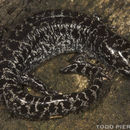en
names in breadcrumbs


It should be noted that A. cingulatum is one of the only terrestrial breeding salamanders that abandons its eggs in North America. (Conat & Collins, 1998) It is also interesting to consider that up to 77-84% of older larvae have damaged tails due to attacks from invertebrates. (Petranka, 1998)
The Flatwoods salamander is a small, rare ambystomid with widely distributed populations. Clearing of land, creating ditches, filling wetlands, and conservation of native longleaf pine forests to create managed tree farms, have destroyed and reduced populations. A. cingulatum is a candidate for federal concern because populations seem to be declining throughout the range (Petranka 1998). It is endangered in South Carolina, rare in Alabama, Georgia, and Florida. Management is complicated, involving both aquatic and terrestrial preservation (Conant 1998).
IUCN Red List of Threatened Species: vulnerable
Development - Life Cycle: metamorphosis
Other than preservation of biodiversity and treasuring a native species to maintain ecosystem equilibrium, there is little economic importance to humans. It could however be hypothesized that salamanders keep insect populations under control
Hatchlings begin feeding immediately on invertebrates and zooplankton, which aids them in growing at a rapid pace. As A. cingulatum becomes juveniles and adults, they remain carnivorous, feeding primarily on earthworms and other insects (Petranka 1998).
South Carolina, Southern Georgia, and Northern Florida, west to southern Alabama.
Biogeographic Regions: nearctic (Native )
Ambystoma cingulatum occupies seasonally wet, pine flatwoods, and pine savannas in the southern United States. The Flatwoods salamander is typically found under logs near small cypress ponds. Traditionally, the Flatwoods salamander was found in sandy, seasonally wet, longleaf pine communities. But, due to European settlement these areas have been replaced by slash pine, or destroyed altogether (Petranka 1998). Adult A. cingulatum are subterranean, living mainly underground in root channels or crayfish burrows (Conant & Collins 1998).
Terrestrial Biomes: forest
Length: 3 1/2- 5 1/16 in.
The Flatwoods salamander is a small highly variable ambystomid, with coloration ranging from specks, to grayish lines that resemble a frosted or lichenlike reticulated pattern. About 5% of A. cingulatum lack the frosted appearance altogether, with 2% having light annuli on their dorsum (Petranka 1998). Costal grooves average at about fifteen. The head is small compared to the shoulder and neck. Sexual dimorphism is slight to non-existent, with sexually active males being slightly shorter in length, and having a swollen cloacal region. Hatchling A. cingulatum are 7.5-11.5 mm long, and are pale brown underneath, and dark brown above (Petranka 1998). The young develop a yellow stripe that runs the length of the body. Older larvae have a paler stripe that may be retained up to one year after metamorphosis. While variations in coloration are often geographic, subspecies are not recognized (Conant & Collins 1998).
Other Physical Features: ectothermic ; bilateral symmetry
The male Flatwoods salamander reaches sexual maturity at one year, but often does not breed until the following season. The females are mature and breed during their second year (Petranka 1998). Breeding populations range from 200-400 adults. Migration to breeding sites such as ephemeral habitats like ditches, burrow pits, marshy ponds, and swamps is triggered by rainy weather from mid October to early February. The adults move during the heavy rain and cease moving within five hours of the end of rainfall (Petranka 1998). The salamanders travel to the breeding sites located at or near pine flatwoods that support long leaf pine, slash pine, and wiregrass. Males and females migrate together and emigrate in December and January, after spending approximately thirty eight days at the breeding site. They return to their home range, females weighing 37% less after ovipositing. A. cingulatum is one of the only Ambystoma species, other than A. opacum, that courts terrestrially (Petranka 1998). Females lay 1-34 eggs in linear or clumped fashion beneath logs, leaf litter, sphagnum mats, bare soil, bases of bushes, and at the entrances of crayfish burrows (Conant & Collins 1998). The female abandons the eggs and leaves them where they will hatch in about two weeks, triggered by heavy rains that raise the water level. Hatching becomes staggered when it requires multiple rains to fill the pond. The larval period lasts from three to five months (Petranka 1998).
Key Reproductive Features: gonochoric/gonochoristic/dioecious (sexes separate)